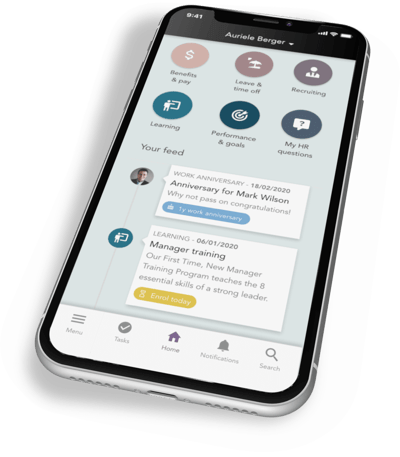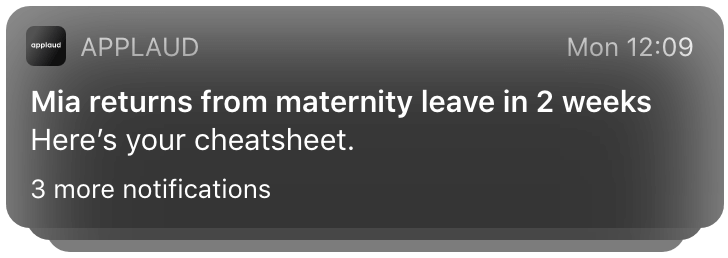Your people don’t want a top-down, dogmatic relationship. And most likely, they’ll leave if that’s what you offer. Instead, employees want space and trust to make their own choices.
How do you fulfill those needs while also building an intentional, positive culture?
Enter nudge theory.
💡 In modern HR Service Delivery, nudging is emerging as a key strategy to reduce HR workloads and guide employees toward self-service, using personalized, subtle prompts woven into everyday workflows via a consumer-grade interface.
Keep reading for everything you need to know about nudging. Including lots of practical and detailed examples of nudging in the workplace.
Just here for the nudge theory workplace examples?
Here’s a summary: feel free to skip ahead.
1. Workplace nudges to encourage collaboration
2. Workplace nudges to promote financial wellbeing
3. Workplace nudges to promote health and wellness
4. Workplace nudges to improve productivity
5. Workplace nudges to encourage an inclusive culture
Here's what this guide covers:
- What is nudge theory?
- Examples of nudges in everyday life
- What does it mean to nudge employees?
- How is nudging different from other leadership tactics?
- Benefits of nudging in the workplace
- Nudge theory workplace examples
- Is AI a gamechanger for nudges in the workplace?
Let’s get going.
 5 use cases for AI in HR service delivery
5 use cases for AI in HR service delivery
This report delves into the dynamic intersection of AI and HR Service Delivery, unveiling five compelling use-cases where AI technologies can catalyze significant improvements. Read Now.
What is nudge theory?
Bursting onto the scene in 2008 with Richard Thaler and Cass Sunstein’s "Nudge: Improving Decisions About Health, Wealth, and Happiness", nudge theory stems from behavioral economics.

According to Thaler and Sunstein, a nudge is a gentle prompt that influences people’s behavior in a predictable way. Nudging influences people to make better decisions. It doesn’t mandate, order, enforce, or control.
Words like gentle, subtle, unobtrusive, and minimal are critical to nudge theory. It protects freedom of choice.
Examples of nudges in everyday life
Nudge theory isn’t an HR concept. Nudging has surfaced wherever human behavior is important. (In other words, almost everywhere.) For example:
- Politics and government policy. Like… placing calorie info on menus to encourage healthier food choices. Or using opt-out as default to encourage people towards organ donation.
- Environment and sustainability. Like… using smart meters to encourage more mindful energy use.
- Finance and charity. Like… offering discounts for prompt payment of fines. Or offering round-up payment to encourage charitable donation.
- Health and wellbeing. Like… sending reminders for health screenings, to encourage uptake and improve public health outcomes. Or promoting months like Sober October and Dry January.
- Marketing. Like… using scarcity or limited time offers to encourage buying behavior. Or any number of tactics in marketing’s toolbox, really. Nudge theory is super relevant to marketing.
Within HR Service Delivery, nudging plays a key role in reducing HR caseloads and empowering employees to self-serve, through friction-free, just-in-time cues surfaced via their everyday tools.
What does it mean to nudge employees?
In HR Service Delivery, nudging refers to how HR leaders use gentle, timely prompts - often embedded in digital touchpoints - to guide employee behavior while reducing the need for direct intervention. Like investing into their pension, or meeting deadlines, or taking part in feedback surveys, or whistleblowing. And so on.
In this sense, nudging can be a major component of culture creation. It’s a particularly popular technique right now because it emphasizes guiding and prompting over dictating or ordering.
Nudging is ultimately a trust-based strategy. As trust becomes more central to employee experience, effective nudging respects employee autonomy while quietly reinforcing helpful behaviors in line with company culture. (That’s one big part of focusing on the ‘human’ in ‘HR’: a major trend of recent.)
Edelman’s Trust Barometer finds that employees are much more trusting when they feel trusted. Workplace nudging is positive because it trusts employees to behave well, without turning into a cultural free-for-all.
To better illuminate what nudging is, let’s talk about what nudging isn’t. We’ll also share some examples of nudging in the workplace as it compares to these other approaches.
How is nudging different from other leadership tactics?
There’s obviously more than one route up the people-management mountain.
In practice, nudging in the workplace isn’t a replacement for any existing leadership technique. It’s an addition. One more tool in your leadership toolbox.
Understanding workplace nudge theory can help you become a more flexible, responsive leader. Here are some of the approaches that nudging could complement:
- Education. Offering training, workshops and suchlike can give employees the knowledge to make informed choices and make voluntary changes. For example, imagine you want to create a more inclusive workplace environment. To achieve this, you might offer lunch-and-learn sessions about inclusive language and unconscious biases.
- Training. Offering targeted training programs can equip your people with the right skills to adopt desired behaviors. This approach recognizes that one big barrier to behavior change isn’t motivation but capability. Nudging someone to, say, meet deadlines isn’t effective unless they have the skills to complete their work.

- Incentives. More involved and directive than nudging, incentives programs offer direct positive reinforcement for desired behaviors or specific goals. This can include anything in your rewards and recognition package, like bonuses, promotion, or commission.
- Role modeling. Role modeling happens in every organization, intentional or not. Senior people set the culture because they lead by example.
For instance, perhaps you want employees to stop working late. Examples of nudging in the workplace might be sending reminders at 5pm or displaying posters about work/life balance. But whatever you say, what employees see their leaders do typically counts for more.
(For example: the CIPD say most organizations see managers as responsible for managing absence.)
- Feedback and coaching. Feedback and coaching are major mechanisms for workplace behavior change. How you set, manage progress against, and provide support towards goals is a major lever for productivity and performance.
- Collaborative decision-making. Getting employees involved with decision-making can foster buy-in, ownership, and engagement unlike anything else. This increased commitment then facilitates behavior change.
Collaborative decision-making processes might happen at an organizational level, or within departments or teams. Individual managers might even use this collaborative decision-making framework within check-ins.
- Policy change. If a workplace nudge is one end of a spectrum, policy change is the other. Changing organizational policy amounts to mandating behavior directly, rather than shaping it indirectly.
For instance, imagine you want employees to start their day earlier. You could nudge that behavior by adding breakfast for early arrivals. Or you could mandate an earlier start time.
There’s place for both tactics. But resorting to policy change when a nudge would do is a little overbearing. Or your people might think so, anyway. Damaging engagement and retention.
Nudging sits among these other tactics. You’ll probably use many of these together to create the workplace culture and working behaviors you care about. But nudging does have some unique benefits that make it well-worth adding to your artillery.
Let’s talk about those. Then we’ll share some practical examples of nudging in the workplace.
6 benefits of nudging in the workplace
Nudging in the workplace has become popular because it’s great for the organization and your people. Here are six big benefits of workplace nudging.
1 – Increase productivity
When nudging effects desirable behavior change, you’ll feel the impact across your important HR and business metrics. Nudging is useful to encourage behaviors that explicitly correlate to productivity, like meeting deadlines, staying focused, and reducing procrastination.
2 – Improve collaboration
Nudging in the workplace can also go miles towards improving collaboration and communication. For example, you could use nudges to encourage employees to share ideas or challenge assumptions regularly.
3 – Improve the employee experience
Nudging is a high-trust, low-maintenance way of influencing behavior that employees typically like. It’s the opposite of micromanagement and strict bureaucracy. Rather, it trusts employees and gives them space. Plus, nudging often incorporates elements of fun that can boost employee engagement, like gamification and competition.
4 – Improve well-being
Employee health and well-being is one of today’s biggest management challenges. Many wellness programs are ineffective at changing behavior and employee stress is at an all-time high.
Left unchecked, these issues impact engagement, absenteeism, culture, productivity. And eventually, revenue. Nudging offers a potential solution.
For more on this “The Healthy Workplace Nudge: How Healthy People, Culture, and Buildings Lead to High Performance” is worth reading.
The authors point out how most traditional wellbeing programs fail to improve health, boost engagement, or lower costs. They position nudging as a powerful tool to build more effective workplace programs that drive true behavior change.
5 – Drive culture change
Nudging in the workplace can be a major mechanism for culture change, by reinforcing desirable behaviors. When you align your nudge strategy to your mission, vision, and values, you can create an authentic work environment and culture.

6 – Deliver on your ESG goals
You might also choose to use nudging to influence behaviors around ESG. For example, reducing waste, consuming less energy, and promoting paperless workflows.
Nudge theory: workplace examples to learn from
We’ve shared lots of nudging examples in the workplace throughout this guide. But let’s drill into them a little more.
Don’t let this list limit you, though. Really, workplace nudging is applicable wherever you want to influence behavior while respecting employees’ individual autonomy. But here are some practical examples of nudging in the workplace to get your synapses firing.
1. Workplace nudge to encourage collaboration
Many organizations want to encourage better collaboration, but this can feel a little intangible.
To nudge this behavior, you could:
- Create comfortable, well-equipped collaboration spaces
- Provide digital collaboration subscriptions and tools
- Move towards an open-plan office model
- Normalize idea-sharing, even at executive-level
- Run a creative workshop to upskill around creative thinking
2. Workplace nudge to promote financial wellbeing
Financial wellbeing is a major driver of employee disengagement and stress, especially right now. For example, Mind say 25% of respondents are working longer hours but also can’t afford social activities. And 18% can’t afford to travel to their usual support networks either. This means the workplace has an enormous responsibility to provide this support.
To nudge better financial wellbeing, you could:
- Send automatic reminders about benefit allowances
- Provide budgeting guidance
- Offer automatic enrollment into savings plans and pension schemes
- Offer and communicate openly about financial support
- Promote free or subsidized social activities
- Provide an on-site financial health counselor (and normalize attendance)
3. Workplace nudge to promote health and wellness
Only 51% of organizations take a strategic approach to employee wellbeing, while 36% admit to being much more reactive than proactive. This is a major missed opportunity, especially as the impact of long COVID continues. Embracing nudging can be part of a proactive health and wellbeing strategy that makes a real difference.
Nudging examples to promote health and wellness:
- Create a designated relaxation, meditation, and stress-busting space
- Send alerts to encourage healthier working behavior
- Promote work-life balance
- Encourage leaders to schedule emails out-of-hours
- Send pulse surveys, to nudge employees to give valuable feedback
- Communicate regularly about your wellness programs
- Provide and openly talk about mental health days
4. Workplace nudge to improve productivity
One of the biggest benefits of nudge theory in the workplace is the ability to improve productivity and improve efficiency. But what does that look like, in practice?
The sky’s the limit… You could:
- Send calendar reminders for focused work sessions
- Provide templates and workflows to make best-practice easy
- Create collaboration spaces
- Offer free lunches to attract remote workers back to the office
- Provide easy mobile access to important info so employees don’t waste time
- Incorporate digital assistants or HR chatbots to minimize admin
- Promote walking meetings
- Set default meeting durations to shorter time frames
… and much more
5. Workplace nudge to encourage an inclusive culture
Gartner recently found that diversity and inclusion is a major priority for CEOs. So much so, it was significantly ahead of financial issues like profitability, cash flow, and capital funding.
This leadership focus on workplace issues is great for HR. But with big expectations comes big responsibility. Nudging can play a key role in helping build a truly inclusive culture.
For example, you could:
- Use pulse surveys to track and measure inclusion
- Establish an anonymous suggestion box
- Host DEI events and speakers
- Establish DEI-focused employee groups to gather ideas
- Ask leaders to include their pronouns in emails
- Use posters and signage to promote key behaviors
Is AI a game changer for nudges in the workplace?
Although employee experience platforms have leveraged previous-generation artificial intelligence for a while now, innovation has ramped up greatly since the launch of generative AI and more recently the advent of the agentic AI era.
AI agents now enable personalized nudging at scale, surfacing timely, contextual prompts across the employee lifecycle. When built into an HR Service Delivery platform, these nudges help deliver intuitive guidance that feels proactive, not prescriptive.
Some examples of this include:
Intuitive next steps for onboarding - Delivered from the employee’s point of view - via AI-powered nudges, tasks, and contextual content personalized by role, department, and location.

AI assistant - For a truly white glove experience, deploying an AI-powered chatbot effectively gives every employees a personal helper. In the context of a new joiner, this bot becomes an onboarding buddy to help guide them through every step, suggest relevant content and quick links to minimise friction, and even complete tasks on an employee's behalf. AI assistants can draw answers to very specific questions from many knowledge sources scattered across the company.
-1.png?width=468&height=468&name=Advanced%20AI%2002%20(1)-1.png)
Automated nudges for managers - AI can collect data on important dates for employees, such as birthdays and start dates, to ensure that managers are reminded of these and important moments are never forgotten.

There are endless examples of nudging in the workplace, as this guide shows. Nudges can be a useful framework to encourage behavior change of almost any type. To embrace nudge theory in the workplace, start by understanding what you want to achieve.
What’s the culture you want to build? What behaviors are desirable?
Then you’ll have a much better idea which processes and technology will best support your strategy.
Want to explore how Applaud could tie in? Get in touch.
Applaud’s HR Service Delivery platform helps HR teams deliver consumer-grade employee experiences built entirely around the employee. From knowledge to journeys to AI assistants, Applaud reduces caseloads, improves productivity, and empowers employees to self-serve—so HR can do more for their people.
Request a demo today.
Ready to unlock the potential of AI in HR?
Discover how to streamline service delivery, reduce HR workload, and deliver more personalized, intuitive support, without adding complexity. Download the AI in HR Service Delivery Playbook for expert insights, practical strategies, and real-world examples that show AI in action.



